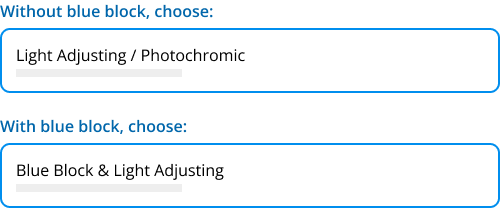So, what are photochromic lenses?
Photochromic lenses, also known as photochromatic lenses, are a type of glasses lens that change colour depending on the amount of UV light they are exposed to. In bright sunlight, these lenses will darken to protect your eyes, but when you go inside or the UV light decreases, they'll turn back to clear, allowing you to see normally. This means you only need one pair of glasses for both indoor and outdoor activities, making it super convenient.
How Do Photochromic Lenses Work?
Photochromic lenses have a special light-sensitive substance in between their layers. This substance is usually made of both organic and inorganic components. When exposed to ultraviolet (UV) light, the photochromic molecules in the lens change shape and darken the lens. But when there's no more UV light, these molecules go back to their original form and the lens becomes clear again. This whole process happens continuously as the lenses adjust to changes in lighting conditions.
Why are Photochromic lenses good for your eyes?
- UV protection: The majority of photochromic lenses provide 100% protection from ultraviolet (UV) rays, which can damage the eyes and nearby skin over time.
- Reduced eye strain and increased visual comfort: The capacity to swiftly adapt to shifting lighting conditions helps reduce eye fatigue.
- Convenience: Having a single pair of glasses for indoor and outdoor use eliminates the need to frequently remove and replace sunglasses or switch between different pairs of glasses.
It's crucial to keep in mind that each person has unique eyes, so what works for one person could not work for another. To find out if photochromic lenses are a good fit for you depending on your unique vision needs and lifestyle, it is best to schedule an eye test and speak with an eye specialist.
Are there any disadvantages of Photocromic lenses?
- Slower response time: In response to shifting lighting conditions, the lenses may take several minutes to fully darken or lighten.
- Temperature sensitivity: In excessively hot or cold temperatures, the lenses could not transition as smoothly.
- Limited colour selection: The only photochromic lens colours commonly offered for eyeglass frames are grey or brown.
- Price: They cost more than conventional clear lenses.
An eye specialist should be consulted to ascertain whether photochromic lenses are a good option for you depending on your unique visual requirements and way of life.
What is the difference between photochromic and transition lenses?
Photochromic and transition lenses both refer to the same thing - eyeglasses that can automatically change from clear to dark (and vice versa) when exposed to sunlight.
FAQs
Can I use Photochromic lenses for driving?
Photochromic lenses can be worn while driving, yes. One pair of glasses can be used for both indoor and outdoor activities, including driving, making them more convenient. The lenses adapt to shifting lighting conditions, lowering eye fatigue and enhancing driving visual comfort. The majority of photochromic lenses also provide complete UV (ultraviolet) radiation protection.
The response time of photochromic lenses can vary, and in some circumstances, they may take several minutes to fully darken or lighten in response to changing lighting conditions. This is a significant factor to keep in mind. This could be a problem when driving in situations with quickly changing lighting, as in tunnels or when entering and leaving buildings. A different set of polarized sunglasses may be preferable in these circumstances.
Are Photochromic lenses good for working on the computer?
When it comes to using a computer, photochromic lenses typically have some anti-reflective coatings and can provide visual comfort. However, they may not be the best option for everyone. If you spend a lot of time on a computer, especially in an office with consistent lighting, blue block lenses might be a better choice.







